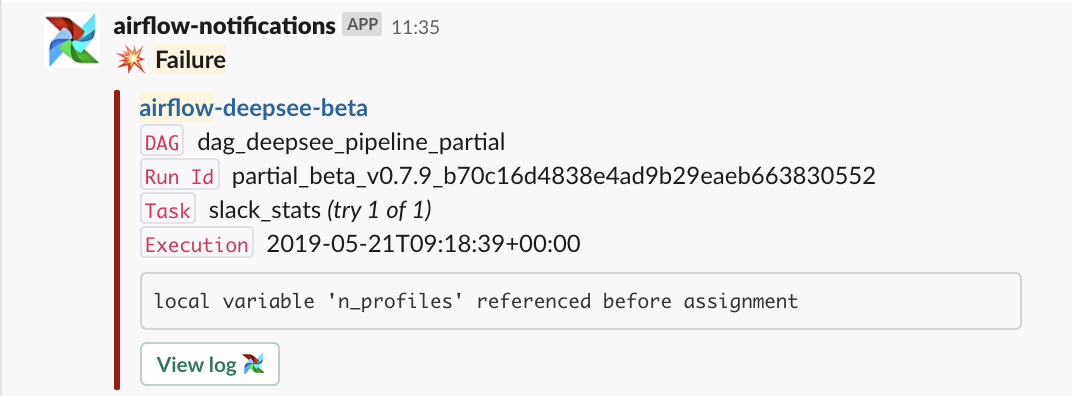Make sure slackclient v1.3.1 is installed (for apache-airflow 1.10).
pip install -U "apache-airflow[slack,...]"Generate a slack legacy token for your workspace and create a SLACK_LEGACY_TOKEN environmental variable.
import os
from airflow.operators.slack_operator import SlackAPIPostOperator
SLACK_LEGACY_TOKEN = os.environ['SLACK_LEGACY_TOKEN']
def send_slack_notification(
message='',
attachments=None,
channel=None,
):
"""Send message to Slack.
message: Text of the message to send. See below for an explanation of
formatting. This field is usually required, unless you're providing only
attachments instead. Provide no more than 40,000 characters or risk truncati
attachments: [list of max 100] dict[s] slack message attachment[s]
see https://api.slack.com/docs/message-attachments#attachment_structure
channel: a channel in your workspace starting with `#`
"""
assert isinstance(message, str) and message or attachments
if isinstance(attachments, dict):
attachments = [attachments]
channel = channel or '#airflow-notifications'
notification_operator = SlackAPIPostOperator(
task_id='slack_notification',
username='airflow-notifications',
icon_url='https://github.com/apache/airflow/raw/v1-10-stable/airflow/www/static/pin_100.png',
token=SLACK_LEGACY_TOKEN,
channel=channel,
text=message,
attachments=attachments,
)
notification_operator.execute()Send a notification with selected context details in a message attachment when a task fails using default_args.
default_args = {
...
'on_failure_callback': failed_task_slack_notification,
}
def failed_task_slack_notification(kwargs):
"""Send failed task notification with context provided by operator."""
domain = extract_domain(
kwargs['ti'].log_url,
with_subdomain=True,
)
dag = kwargs['ti'].dag_id
run_id = kwargs['run_id']
task = kwargs['ti'].task_id
exec_date = kwargs['execution_date']
try_number = kwargs['ti'].try_number - 1
max_tries = kwargs['ti'].max_tries + 1
exception = kwargs['exception']
log_url = kwargs['ti'].log_url
# command = kwargs['ti'].command(),
message = (
f'`DAG` {dag}'
f'\n`Run Id` {run_id}'
f'\n`Task` {task} _(try {try_number} of {max_tries})_'
f'\n`Execution` {exec_date}'
f'\n```{exception}```'
# f'`Command` {command}\n'
)
attachments = {
'mrkdwn_in': ['text', 'pretext'],
'pretext': ':boom: *Failure*',
'title': domain.split('.')[0],
'title_link': f'https://{domain}',
'text': message,
'actions': [
{
'type': 'button',
'name': 'view log',
'text': 'View log :airflow:',
'url': log_url,
'style': 'primary',
},
],
'color': 'danger', # 'good', 'warning', 'danger', or hex ('#439FE0')
'fallback': 'details', # Required plain-text summary of the attachment
}
send_slack_notification(attachments=attachments)
Hi @ddelange, where i can find the method extract_domain?